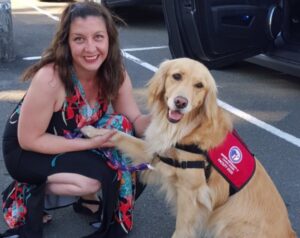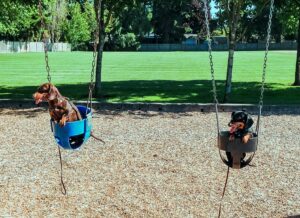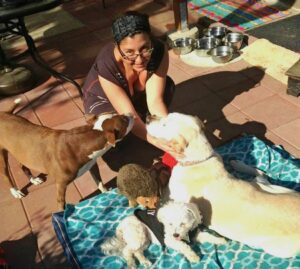It’s that time of year again! Here are some great ways to prepare for the 4th of July:
Have a kennel covered and in a quiet bedroom or first floor level of home to create a safe space for them to hide. Don’t close kennel door if your dog is not kennel trained but confine them to one room.
Dog relaxation music played at low level in their space. Turn it up if fireworks sounds are extreme to drown them out. Use fans to add white noise especially if room is warm.
Example of relaxation music: https://youtu.be/a1sbRMdifEY
Prepare early: This product can help anxious dogs and has no odor. It can take up to 2 weeks to permeate the room.
Adaptil Calm Home Diffuser for Dogs (30 Day Starter Kit): https://www.amazon.com/…/B01AW71ILU/ref=cm_sw_r_cp_apa_i_u.…
Pheromone collars and Pheromone spray can be applied to crates, beds and cars for immediate effect.
Sounds of fireworks:
YouTube has a great variety of sound effects like fireworks, barking dogs, doorbells, etc to help desensitize your dog to these sounds over time when played at low levels and using treats to reward no response from the dog. Or while they are eating a special, long lasting treat. Seek professional advice to learn how to correctly train through this process.
If you have a sound sensitive dog, it is best to begin the desensitization process months before 4th of July. You can do this by playing the sound effects of fireworks at very low levels only during feeding time, during training, while eating special chews like Bully Sticks, or while enjoying a food stuffed Kong as well as during play time. It is very important to keep the levels low, you don’t want your dog to react to the sounds or stress. They can be played while you are reading a book and cuddling with your dog on the couch. By doing this you are pairing a normally stressful event with something that is soothing and enjoyable.
Suggested long lasting treats and chews:
If fireworks are extreme in your area, it is best to begin preparing early. But if you haven’t, pick up a variety of Bully Sticks, pig’s ears, antlers and a variety of chews. Rawhides and hooves are very dangerous for dogs and not suggested. Chews are a great addition to crate training, working with separation anxiety, and they give your dog something to do while you are away. Nylabones can be useful instead of Bully Sticks, if your dog tends to swallow large pieces of toys or the remaining end of a bully stick. Bully sticks should only be given during close supervision and not left alone with them when you are gone. A frozen Kong stuffed with their meal kibble and canned food, or flavored ice cubes with peanut butter can be a good alternative when left alone. Dog should be separated in multiple pet homes, to prevent resource guarding. Even separated from curious cats who may innocently wander near the dog while they are eating, which could cause the dog to resource guard.
After a stressful event, dogs’ cortisol levels are increased. This means that they can be extra sensitive to triggers they may normally not be, days after the event. It is wise to use heavy supervision in multiple dog homes, and keep walks short and in minimally congested environments with the intent of sniffing in lieu of long walks and exercise. Extra exercise like fetch or running can be helpful with one dog at a time to lower cortisol levels. One-on-one time is essential for homes with multiple pets.
Lower your expectations, keep corrections to a minimum, and heavily reward all good behavior during this time. But the idea is to give your dogs a break for a few days after a stressful event, and expect unpredictable behavior and reactivity.
Food puzzles are helpful to teach a dog to work for their food and distract them during stressful events. There is a Facebook group called “Canine Enrichment” that has a lot of good ideas on how to provide enrichment for your dog to keep them mentally stimulated. Teaching your dog to enjoy these food puzzles should be introduced before a stressful event, like fireworks.
Please avoid the “canine enrichment and training group”, as there is a lot of bad advice given in regards to training. What works for one dog, may have ill effects or not apply to your own dog. Working with a positive trainer is helpful to save you time, money and energy applying techniques that work for each individual dogs needs.
Day of fireworks:
Ensure your dogs have eliminated before the fireworks start.
Feed their meals a little earlier in the day, so they may eliminate a little earlier than usual.
Give them an extra long walk that day and extra play to help wear them out a bit.
If you have to take your dog out in the evening during fireworks, leash them, even in their own yard. I often utilize a front clip harness/collar combination for dogs that are flight risks or during the Blue Angels or fireworks. Loosen the collar a little bit, and connect the collar to the front loop of the harness which prevents them from pulling out and running away. When a dog is in flight mode, they can jump fences they otherwise could not. They can charge through windows, screens, barriers and hurt themselves. Chained dogs can jump fences and hang themselves, they are not thinking clearly when panicked and it’s up to is to set them up for success by bringing them indoors. A slip lead may be used as well, if you don’t have a harness for your dog as they can slip out of collars. If you use a prong collar, they can seriously injure themselves in a state of distress and you are now associating the sound of fireworks with pain and intensifying their fears.
Keep windows closed if they are in a room by themselves, as dogs have been known to jump through screens due to extreme panic.
Ensure your dog is wearing their collar with tags at all times in case someone leaves a door or a gate open.
Ensure your microchip is registered and up-to-date in case they get lost. It is wise to check your dog’s microchip routinely is still in place on the back of the neck when visiting your vet. Some microchips can slide down to their legs and in other locations of the body.
My best advice its to stay home with your dogs during 4th of July and help them through this stressful event. Do not take your dog to a fireworks show, or a friend’s house that they are unfamiliar with. Flooding or exposing them to a firework show will not train your dog to enjoy them. If you have people over to celebrate, please leave your dog inside the house. If they are stressed and anxious, this could create a negative association to your specific guests. Don’t let your dog watch the fireworks, there is no need to expose them to it directly. Watch body language and look for signs of fear. Puppies may not react to the event and may seem indifferent because they haven’t entered their fear period, conditioning them is still essential. Once they hit the fear period, conditioning is more difficult. If your dog has separation anxiety, save that struggle for another day and protect them from the experience of fireworks or stay with them inside their safety zone.
Give your nervous dogs space from kids and other animals. Many people hug or lay on our dogs to console them, but that is something that should be avoided especially while under stress. Dogs may tolerate it under normal circumstances but it may cause them to correct your child for being too close when they are stressed.
Pick up anxiety medications from vet before a stressful event, there is no shame in using it if it helps your pet stay calm and prevents trauma. Talk to your vet about trial usage and dosage.
Over-the-counter calming aids like Vetricin composure chews or CBD oil may help. I personally buy my CBD oil from www.suziespettreats.com. I use oil instead of treats because I feel it is easier to experiment with the dosage and start with a small amount.
Taking a car ride with a delicious stuffed Kong is your last alternative during the fireworks so you can drive away from the sounds. Make sure dog is leashed and windows locked and closed. I spent a 4th driving Pip around for 2 hours and moving from one quiet place to the next.
Remember dogs hearing and smell is much stronger than our own. What we think is normal, can seem like a war zone to our dogs.
I hope this helps!



